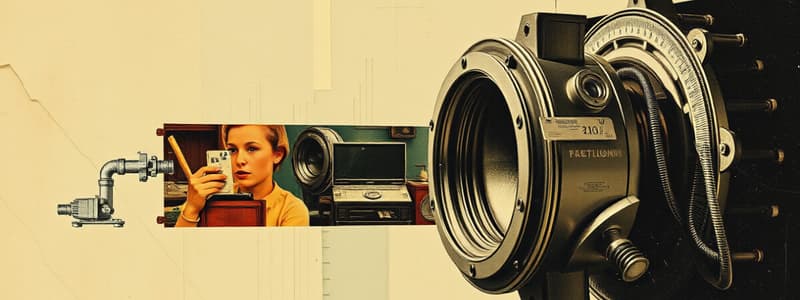Podcast
Questions and Answers
What defines a vacuum?
What defines a vacuum?
- An enclosed space partially emptied of gas (correct)
- A space entirely devoid of gas
- A space with equal gas density compared to the outside atmosphere
- A space filled entirely with gas
Which of the following is NOT a reason for establishing a vacuum?
Which of the following is NOT a reason for establishing a vacuum?
- To facilitate unwanted reactions (correct)
- To enable plasma etching
- To allow for unobstructed evaporation
- To prevent contamination
How is vacuum measured?
How is vacuum measured?
- By the pressure within the chamber (correct)
- By the temperature of the gases present
- By the amount of light present
- By the density of the gases
What is considered 'High Vacuum' in terms of pressure?
What is considered 'High Vacuum' in terms of pressure?
What characterizes gas flow in the roughing process?
What characterizes gas flow in the roughing process?
What mechanism does the Rotary Vane Pump use to remove gases?
What mechanism does the Rotary Vane Pump use to remove gases?
Which statement about gas behavior at High Vacuum is accurate?
Which statement about gas behavior at High Vacuum is accurate?
What is the lower limit of Ultrahigh Vacuum in terms of pressure?
What is the lower limit of Ultrahigh Vacuum in terms of pressure?
What distinguishes a Cryosorption Pump from other pumps?
What distinguishes a Cryosorption Pump from other pumps?
Which pressure unit is NOT commonly used to measure vacuum?
Which pressure unit is NOT commonly used to measure vacuum?
What is a primary advantage of using EB Evaporation over Sputtering?
What is a primary advantage of using EB Evaporation over Sputtering?
Which process can only be used for non-conductive materials?
Which process can only be used for non-conductive materials?
What is the main disadvantage of Sputtering compared to EB Evaporation?
What is the main disadvantage of Sputtering compared to EB Evaporation?
Which configuration in Sputtering allows for the best uniformity?
Which configuration in Sputtering allows for the best uniformity?
What materials can Tungsten heating evaporation effectively deposit?
What materials can Tungsten heating evaporation effectively deposit?
Which of the following is NOT a typical application of EB Evaporation?
Which of the following is NOT a typical application of EB Evaporation?
In Sputtering, what is the role of Argon ions?
In Sputtering, what is the role of Argon ions?
What is a common limitation of Sputtering in terms of directionality?
What is a common limitation of Sputtering in terms of directionality?
What is the primary purpose of thin film deposition technologies?
What is the primary purpose of thin film deposition technologies?
Which of the following is a physical vapour deposition technique?
Which of the following is a physical vapour deposition technique?
What is a significant advantage of using electron-beam evaporation in integrated circuit fabrication?
What is a significant advantage of using electron-beam evaporation in integrated circuit fabrication?
Which of the following statements about thin film deposition techniques is true?
Which of the following statements about thin film deposition techniques is true?
Which method is preferred for achieving uniform deposition during evaporation processes?
Which method is preferred for achieving uniform deposition during evaporation processes?
What technique involves heating materials to the point of vaporization in a vacuum process?
What technique involves heating materials to the point of vaporization in a vacuum process?
What are the common applications of thin film deposition technologies?
What are the common applications of thin film deposition technologies?
What is the relationship between PVD and CVD techniques in thin film deposition?
What is the relationship between PVD and CVD techniques in thin film deposition?
Flashcards are hidden until you start studying
Study Notes
Vacuum Definition and Production
- Vacuum refers to an enclosed space that has been partially evacuated of gas, resulting in fewer gas molecules compared to the external atmosphere.
- Gas removal from a chamber is achieved using vacuum pumps.
Importance of Vacuum
- Vacuum environments prevent contamination and unwanted reactions, particularly oxidation.
- Create unobstructed pathways for processes like evaporation.
- Enable ionization processes essential for plasma etching and sputtering.
Vacuum Measurement
- Vacuum levels are quantified by measuring pressure; fewer gas molecules result in lower pressure levels.
- Higher vacuum levels correspond with lower pressure readings.
- Common pressure units include Torr, Pascal, and Bar.
Levels of Vacuum
- Rough Vacuum: Ranges from atmospheric pressure (760 Torr) to 10^-3 Torr.
- High Vacuum: Extends from 10^-3 Torr down to 10^-8 Torr.
- Ultrahigh Vacuum: Defined as pressure levels lower than 10^-8 Torr.
Roughing Process and Gas Flow
- In the roughing process, gas flow is classified as viscous.
- Rotary Vane Pump operates by mechanically pushing gases from the chamber and exhausts them.
- In Rotary Vane operation, gases expand into a created space, are swept and compressed, and expelled through a discharge valve in continuous cycles.
- Cryosorption Pump functions by trapping gases and lowering their temperature, transforming gas into solid state.
Nature of High Vacuum
- After the roughing phase, gas flow transitions to a molecular state in High Vacuum conditions.
- In a molecular state, gas particles are far enough apart that they do not impact one another, resulting in a non-viscous flow.
Thin Film Deposition Overview
- Technique for applying thin layers of material onto various substrate materials, enhancing surface properties without altering bulk characteristics.
- Important in achieving specific thin film properties, often with cost-effectiveness compared to bulk material changes.
- Applications are vast and limited primarily by material science capabilities and innovative ideas.
Applications of Thin Film Deposition
- Used in tools like diamond-coated steel cutters and titanium-coated steel drill bits for hardening.
- Essential in integrated circuit (IC) fabrication through processes like photolithography and etching for layered and patterned designs.
Thin Film Deposition Techniques
- Divided into two main categories: Physical Vapour Deposition (PVD) and Chemical Vapour Deposition (CVD).
PVD Techniques
-
Evaporation
- Utilizes a vacuum environment to heat materials for vaporization.
- Follows geometric efficiencies with 2R (2 times radius) for uniformity and 1R circumference for perpendicular deposition.
-
Electron Beam Evaporation
- Employs tungsten heaters or high-intensity electron beams with minimal contamination.
- Suitable for metals and dielectrics with high melting points; used in applications like car lights and decorative coatings.
-
Sputtering
- Plasma process using argon gas to dislodge atoms from a target material.
- Ejected atoms then deposit onto a substrate; different power sources apply for conductive and non-conductive materials.
- Variants include Down Sputtering, Up Sputtering, and Side Sputtering based on target and substrate orientation.
Comparison of EB Evaporation vs. Sputtering
-
EB Evaporation
- Achieves uniformity primarily with a planetary design.
- Generates moderate density, stress, and adhesion in films.
- High deposition rates for metals and dielectrics make it useful for applications like optical coatings, laser optics, and solar panels.
- Directionality allows for lift-off techniques in MEMS applications.
-
Sputtering
- Offers excellent uniformity without the need for a planetary design.
- Provides good film density, stress, and adhesion but has a low directionality, restricting certain techniques like lift-off.
- High system cost and complexity associated with the technique.
- Primarily used for media and Diamond-Like Carbon (DLC) in hard disk drives, and for tailoring optical and electrical properties.
Studying That Suits You
Use AI to generate personalized quizzes and flashcards to suit your learning preferences.





